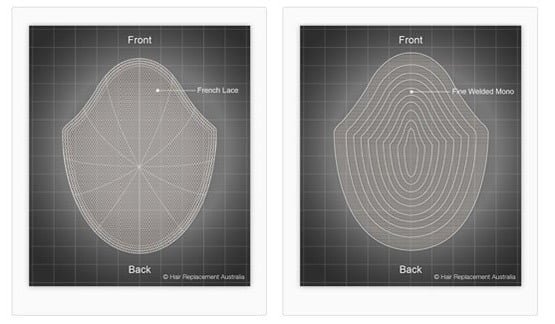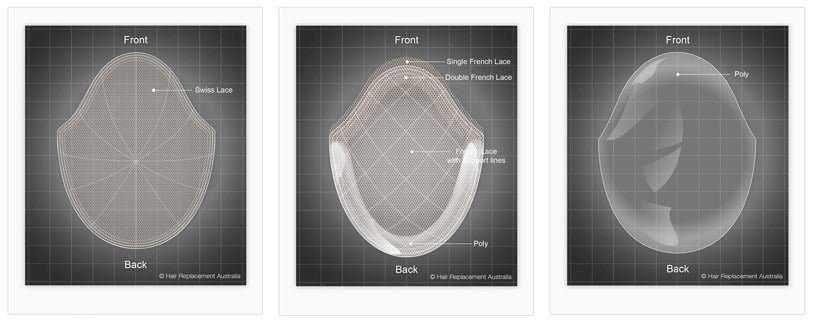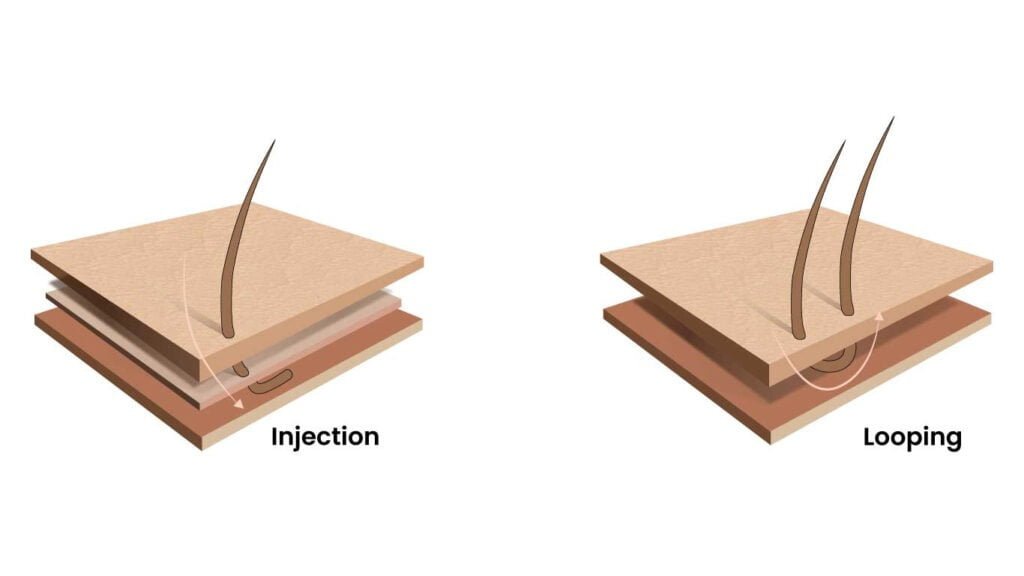Hair Systems
Hair Systems - Base Designs
Hair system bases are one of the most crucial parts of a hair replacement system. Unfortunately they can also be the most confusing.
Non Surgical Hair Replacement , Strand-by-Strand, Skin Grafts, Hair Bonding , Hair Replacement , Hair Patch , Hair Graft, Cosmetic Follicle Therapy, Follicular Hair Replacement, Clear Skin, Invisible Thin Skin, Super Skin, Silk Base, New York Lace, Hollywood Lace, High Definition, Wig, Men’s Hairpiece, Toupee…. What the?!?
Even though the hair replacement industry uses an abundance of decorative names to market these hair system bases, there really is only two types of basic construction materials: Polymer and Mesh Fabric.
Polymers create an imitation skin-like material and are commonly referred to as a ‘poly’ hair system because of their close resemblance to real skin tones.
Depending on the type of polymers used, polyurethane bases can be extremely durable and because of this are sometimes added to other hair systems to strengthen stressed areas such as the part and the base perimeter. Polymer bases are constructed from two primary materials: Silicone and/or Polyurethane, they are not breathable and can be very hot and uncomfortable.
Silicone by nature is very durable as it repels body acids and other elements. However it cannot be dyed, so achieving a natural skin tone is difficult, plus attaching these hair systems with hair tape or hair glue is virtually impossible.
Polyurethane is not as durable as silicone but it can be dyed easily to resemble natural skin tones and can be more easily attached using hair tape and hair glue. On the downside, polyurethane is vulnerable to body acids and will turn yellow and breakdown over time. To overcome this, silicone and polyurethane are sometimes joined during construction of the base.
Mesh fabrics are used to create a fine lace material and are typically made of either nylon or polyester. There are hair system bases constructed entirely of mesh fabric, but more commonly this fabric (lace) is only used in the more exposed areas as they provide a more natural look. Depending on the weight / thickness of the material it may have a shorter lifespan.
• Polyester (Lace) – is a multifilament (multi strand) fiber that is knitted, not woven. The knitting process gives it a distinct honeycomb look.
• Nylon (Monofilament) – is a monofilament (single strand) thread woven to create the mesh.
Mesh fabric hair systems can be very delicate and easily tear. They are vulnerable to body acids which can cause early deterioration and damage. It is common to replace mesh fabric hair systems more regularly than a polymer hair system. Despite these drawbacks, mesh fabric remains the most popular type of hair replacement system. They consistently provide a natural and undetectable hairline plus they are comfortable and temperature cool to wear.
Design Categories


Hair System Ventilation
Ventilation has a lot to do with both the appearance and durability of your hair replacement system. Knowing a little bit about ventilation and how the hair is attached might help you achieve a better looking hair system.
How is the hair attached? The most popular types of ventilation are called knotting, injection and looping. Knotting is most commonly used in lace hair systems but can also be used with poly hair systems as well. Injection and looping are often confused with one another. Both types are only available in poly hair systems as they appear as if the hair is growing from the scalp.
Injection Ventilation
Injection Ventilation - is most common in poly hair systems as it requires a thicker base so the hair can be sealed between a layer of polyurethane and silicone. The best part is there is no hair return. That means all the hair follicles go in the same direction so tangling is rarely an issue.
Looping Ventilation
Looping Ventilation - on the other hand means the hair is sewn through the base almost in a V or U pattern. There is a hair return with looping and it isn’t as strong as injection. However, the polyurethane layer can be much thinner.
The Hair Knotting Process
Knotting is most common in lace hair systems. The hair is tied around the mesh material in very tiny knots. These hair knots are usually available in a few different sizes: double knots, single knots, half knots and Bleached knots.

Double Knot – is ideal for a very thick hair system density with lots of volume and height. The bigger hair knot size makes it difficult to lay the hair down flat so the hairstyle should be fuller.
- Single Knot– is the easiest to lay flat and best suit a freestyle hair pattern.
Half Knot– is the smallest and most undetectable hair knot and provide some lift. The half knot is even smaller than a single knot and can also be used in a slick back hair style.
Bleached Knot – is bleaching which takes out most of the colour leaving a virtually invisible hair knot. The drawback is that it can weaken the hair knot reducing the lifespan.
Attaching Hair Systems
Learn how to correctly attach a hair system. By educating yourself and learning more will only help you make an informed decision before purchasing any products. Contact NEEDS HAIR STUDIO if you need any further information or advice.
After your guide point is marked in the center of your forehead use a positioning spray and generously spray onto your scalp. This is crucial because the positioning spray will give you a few extra moments after the hair system is placed onto your head to adjust it into the right position. This is an essential step. Without it, hair systems may immediately stick to your scalp as soon as it makes contact with your skin. This could potentially make a mess with a crooked hair system being the end result.
For even better results, spray the underside of the hair systems base where the hair tape or hair glue adhesive has been applied.
Hold both sides of the hair system and slowly lower it down onto your head so the entire base touches your scalp at about the same time.
Once resting on your head, you should be able to move it freely over your scalp in all directions until it is aligned with your forehead guide / indentation and all around the edges of your natural growing hair.
Wait several minutes for the hair positioning spray to evaporate and then begin carefully patting or pushing down on the hair replacement system to better secure the adhesion and set it into place. You can also use the underside of a hair vent brush or comb, gently pressing down over the hair system starting from the top of your head, moving out toward the perimeter.
Applying Hair Glue
Learn how to apply hair glue to hair system. By educating yourself and learning more will only help you make an informed decision before purchasing any products. Contact NEEDS HAIR STUDIO if you need any further information or advice.
- Apply a thin layer of adhesive on your scalp.
- Apply a thin layer to the underside of the base. Never apply directly to lace.
- Allow the glue adhesive to dry for 3-5 minutes each application.
- Position the hairline, then roll the hair system back over the scalp and press firmly.
- Leave to dry in place for several minutes before styling.
- Applying two coats will further strengthen the adhesion.
- Keep the hair system dry and perspiration free for 24 hours.
- Each layer of adhesive must dry for 3-5 minutes.







